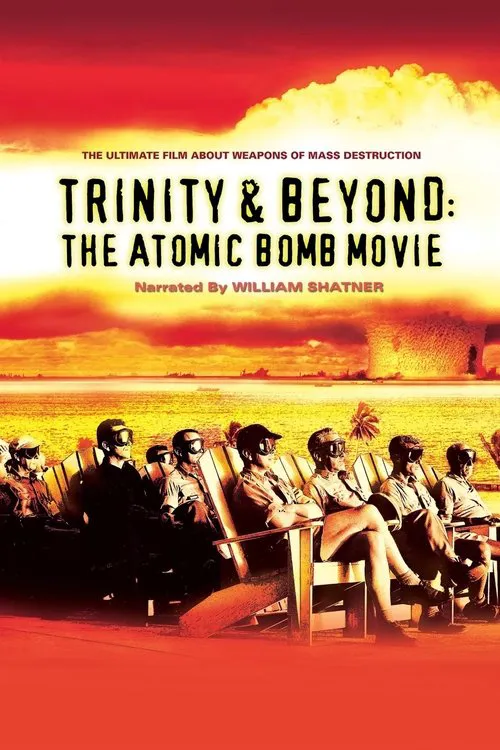Trinity and Beyond: The Atomic Bomb Movie

Plot
The atomic age dawned on humanity with the detonation of the world's first nuclear device, codenamed "Trinity," on July 16, 1945. This groundbreaking event marked not only the beginning of nuclear warfare, but also the launch of a frantic competition between the United States and the Soviet Union to develop and test more powerful nuclear arms. "Trinity and Beyond," an award-winning documentary narrated by none other than William Shatner, delves into the dark history of nuclear development and testing from 1945 to 1963, presenting a fascinating yet unsettling exploration of one of humanity's most destructive achievements. The documentary begins by examining the lead-up to the Trinity test, which saw a team of scientists working tirelessly to develop the bomb. The team, led by J. Robert Oppenheimer, was composed of some of the most brilliant minds in the field, including Enrico Fermi and Ernest Lawrence. Despite their initial reservations, the scientists eventually overcame their concerns and successfully detonated the "Gadget," a plutonium-based bomb designed to demonstrate the possibility of nuclear warfare. The Trinity test would go on to play a pivotal role in the development of the atomic bomb. The shockwave generated by the blast was so powerful that it shattered windows and damaged buildings hundreds of kilometers away. In the aftermath of the test, the United States realized the devastating potential of nuclear warfare and quickly set about developing more powerful bombs. This process of competition would drive the development of ever-more destructive nuclear devices, including hydrogen bombs that released enormous amounts of energy equivalent to millions of tons of TNT. However, the development of nuclear bombs was not a solo endeavor. The Soviet Union, spurred on by the news of the Trinity test, rapidly accelerated its own nuclear development program. This Cold War escalation would lead to the development of hundreds of nuclear devices, including some of the most powerful bombs in existence. "Trinity and Beyond" presents footage of several of these tests, each one serving as a stark reminder of the devastating potential of nuclear warfare. One of the most striking aspects of the documentary is its use of previously unreleased footage. Using classified government files, the filmmakers have uncovered a wealth of previously unseen material, including footage from nuclear tests in the Pacific and Siberia. The footage is often stark and unsettling, capturing the sheer scale and power of the bombs. For example, a test in the Pacific, codenamed Operation Redwing, shows a massive hydrogen bomb detonating in mid-air, generating an enormous mushroom cloud that blocks out the sun. In addition to showcasing the destructive power of nuclear bombs, "Trinity and Beyond" also humanizes the people involved in their development. The documentary includes interviews with some of the scientists who worked on the development of the atom bomb, including those who expressed initial reservations about the project's ethics. Their personal stories offer a poignant reminder that, behind the cold, calculating face of nuclear warfare, were individuals who were deeply conflicted about their role in shaping the fate of humanity. One such scientist was Albert Einstein, whose famous equation, E=mc2, has become synonymous with the atomic age. As the documentary reveals, Einstein was initially hesitant to support the development of the nuclear bomb, citing concerns over its devastating potential. Despite his reservations, Einstein eventually came to see the bomb as a necessary evil in the face of Nazi Germany's aggressive militarism. The documentary also explores the devastating consequences of nuclear testing. One of the most striking aspects of the film is its depiction of the devastating effects of radiation poisoning on the people and environments surrounding nuclear test sites. Footage of the Marshall Islands, where several US nuclear tests took place, serves as a stark reminder of the long-lasting impact of nuclear activity on human health and the environment. As the years passed, nuclear testing continued unabated, with each country pushing to develop and test more powerful devices. This cycle of escalation culminated in the Cuban Missile Crisis, which brought the world to the brink of nuclear war. The crisis was narrowly averted, but it served as a stark reminder of the catastrophic consequences of nuclear conflict. "Trinity and Beyond" ends on a haunting note, as William Shatner narrates a somber reflection on the legacy of nuclear warfare. The documentary presents a stark reminder that, while we have made significant progress in developing more sophisticated nuclear devices, we have yet to learn from our past mistakes. The devastating legacy of nuclear testing continues to haunt us, with many communities still suffering from the effects of radiation poisoning. "Trinity and Beyond" serves as a poignant reminder of the devastating potential of nuclear warfare and the urgent need for disarmament and peace.
Reviews
Recommendations




